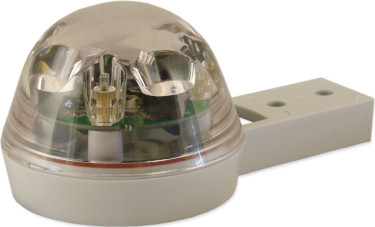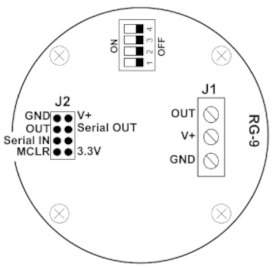Hydreon RG-9
Overview
| Manufacturer | Hydreon |
|---|---|
| Name | Hydreon RG-9 |
| ESPHome component | sensor/hydreon_rgxx and binary_sensor/hydreon_rgxx |
| Datasheet | 2022.02.17-rev-1.200-rg-9_instructions.pdf |
| Serial protocol | rg-9_protocol.pdf |
| Pinout | rg-9-pinout.png |
The Hydreon RG-91 is a rain gauge that uses IR light sensors2to detect rain falling on its curved plastic lens, and can reliably detect rain very fast as it is specifically designed for "is it raining now?"3 use cases.
The Hydreon RG-9 Solid State Rain Sensor is a rainfall sensing device intended to detect and communicate when a pre-selected rain intensity has been reached or exceeded. The RG-9 is rugged, reliable, and maintenance-free.
The RG-9 uses beams of infrared light within a plastic lens about the size of a tennis ball. The round surface of the lens discourages collection of debris, and the RG-9 has no moving parts to stick, and no water-pathways to clog.1
Hydreon also makes other models4 designed for other use cases5 (for example irrigation control and codensation sensing).
The rain gauge uses a serial protocol over UART6. There is also
has an OUT header connected to open collector7 (NPN
transistor) output.
The main output is NPN Transistor Collector, commonly known as an Open Collector.
When the output is activated (will differ on when this is done for the RG-9 and RG-15) the collector is pulled low and whatever load resistor is connected will also be pulled low.
The beauty of an open collector system is that it can be used for level translation. The internals of the RG-9 and RG-15 are 3.3VDC. You are not restricted to that range with the open collector. The only requirement is that the ground is common8.
When the rain gauage detects rain, it will both send a command over the UART bus and
pull the OUT pin LOW.
Specifications
| Name | |
|---|---|
| Supply voltage | |
| Forward current (nominal) | 9 |
| Forward current (raining) | |
| Operating temperature range | to |
| UART voltage | |
NPN transistor (OUT header) | / / (max) |
Pinout
The J1 headers have screw terminals and are mounted horzontally, and does not
have headers for the UART serial interface.
| Header | Usage | Notes |
|---|---|---|
J1 GND | GND | Same as J2P1 |
J1 V+ | Power supply | Same as J2P2 |
J1 OUT | NPN OUT | Same as J2P3 |
The J2 headers are standard Dupont dual-row 8P connectors with 2,54mm pitch.
| Header | Usage | Notes |
|---|---|---|
J2P1 | GND | Same as J1 GND |
J2P2 | Power supply, V+ | , voltage regulated. Same as J1 V+ |
J2P3 | NPN OUT, pulls HIGH for rain | Same as J1 OUT |
J2P4 | UART RX | |
J2P7 | MCLR | Restarts RG-9 if pulled HIGH |
J2P8 | Bypasses voltage regulator |
All of the headers in J1 are also available on J2.
ESPHome config
The rain guage uses UART for serial communication10, so first configure a UART bus:
uart:
- id: ${uart_id}
tx_pin:
number: ${rg9_pin_tx}
rx_pin:
number: ${rg9_pin_rx}
baud_rate: "9600"
Most ESP32 boards have 2+ hardware UART interfaces that can be used with any available
GPIO pins. Avoid using any strapping pins, as they can be pulled HIGH/LOW on start.
The default baud rate used by the rain gauge for UART is 9600 bits/s, though it seems to support up to 57600bits/s9.
UART sensors
Then configure the hydreon_rgxx component for the sensor data that is read over serial:
sensor:
- platform: hydreon_rgxx
model: "RG_9"
id: "rg9"
update_interval: 20s
disable_led: false
moisture:
id: rg9_rain_lvl
name: "Rain level"
state_class: measurement
temperature:
name: "Device temperature"
binary_sensor:
- platform: hydreon_rgxx
hydreon_rgxx_id: "rg9"
too_cold:
name: "Temperature status"
lens_bad:
name: "Lens status"
em_sat:
name: "Emitter saturation"
Using the OUT header
To read the OUT pin, set up binary_sensor using the gpio platform.
binary_sensor:
- platform: gpio
id: rg9_rain_gpio
pin:
number: "${rg9_pin_out}"
inverted: true
mode:
input: true
pullup: true
name: "Rain detected GPIO OUT"
entity_category: ""
device_class: "moisture"
publish_initial_state: true
The rain gauge will pull OUT to LOW to signal rain, so enable the internal
pull-up resistors.
Template binary_sensors for rain detection
Use the template platform to create a binary_sensor using the rain level
readings over UART:
binary_sensor:
- platform: template
id: rg9_rain_uart
name: "Rain detected UART"
device_class: moisture
entity_category: "diagnostic"
lambda: |-
if (id(rg9_rain_lvl).has_state()) {
int rain_lvl = id(rg9_rain_lvl).state;
return rain_lvl > 0;
}
else {
return {};
}
To have one single sensor for "Is it raining?", make another binary_sensor using
the template plateform:
binary_sensor:
- platform: template
id: rg9_rain
name: "Rain"
device_class: moisture
lambda: |-
bool uart = id(rg9_rain_uart).state;
bool gpio = id(rg9_rain_gpio).state;
return uart || gpio;
filters:
# Optionally set a delay for the binary_sensor to turn off
- delayed_off: !lambda |-
return id(rg9_rain_delay_off).state;
Using the MCLR pin
If you wired the MCLR pin, you can use that to restart the rain gauge:
switch:
- platform: gpio
id: rg9_mclr
name: "${hostname} RG9 MCLR"
entity_category: ""
pin:
number: ${rg9_pin_mclr}
on_turn_on:
- delay: 500ms
- switch.turn_off: rg9_mclr
Since there is no button component for the gpio platform, you need to use
an on_turn_on automation to pull the pin back to LOW after restarting the rain gauge.
References
RG-9 & RG-15 FAQ - Hydreon rain sensors, lists connector sockets for J2, input voltage specifications, open collector transistor specs and technical details.
Hydreon RG-15 rain sensor - Home Assistant forum: Information from Hydreon's support about power supply and how the models differ.
Home Assistant forum thread, posts from janick
Field Kit: Rain Gauge RG-9 - Mark Naylor's blog, The University of Edinburgh
UART button - ESPHome: send a pre-defined sequence of bytes on an UART bus.

